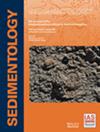利用地球化学(Y/Ho)替代数据识别浅海碳酸盐序列中的隐性最大淹没面
IF 2.8
2区 地球科学
Q1 GEOLOGY
引用次数: 0
摘要
由于具有诊断意义的主要沉积沉积结构和与深度相关的粒度变化趋势很少被保留下来,因此,为绝大多数新生代碳酸盐岩平台序列建立一个全面的序列地层学框架尚待时日。在两个最重要的层序地层面中,虽然可以通过岩溶发育或硅质岩材料的出现可靠地识别次生不整合面,但在岩性一致的浅海碳酸盐层序中,最大洪积面的划分仍然很困难。本研究试图在浅海碳酸盐平台序列中记录的古新世-始新世热极值负碳同位素偏移体中确定全球有据可查的最大淹没面。结果表明,碳酸盐部分的钇钬比值(Y/Ho 比值)与碳酸盐微地层一起可靠地记录了海平面的变化。Y/Ho 比值在 70 至 80 之间时,可划分出最大海平面状态(研究区间内最开阔的海洋状态)和最大洪水面的地层位置。由于 Y/Ho 比值在整个成岩过程中保持相对稳定,因此可用于识别浅海碳酸盐平台序列中的最大泛滥面。同样的方法也可用于硅质岩-碳酸盐岩混合系统。本文章由计算机程序翻译,如有差异,请以英文原文为准。
Recognition of a cryptic maximum flooding surface in shallow marine carbonate sequences using geochemical (Y/Ho) proxy data
Since diagnostic primary depositional sedimentary structures and depth‐dependent grain‐size trends are rarely preserved, building a comprehensive sequence stratigraphic framework for the vast majority of the Phanerozoic carbonate platform sequences is pending. Among the two most important sequence stratigraphic surfaces, while the subaerial unconformity can be reliably identified by either karst development or the appearance of siliciclastic materials, the demarcation of the maximum flooding surface remains difficult in lithologically uniform shallow marine carbonate sequences. The present study attempts to identify the globally documented maximum flooding surface within the body of the negative carbon isotope excursion of the Palaeocene–Eocene Thermal Maximum recorded in the shallow marine carbonate platform sequences. The results show that, along with the carbonate microfacies, the yttrium to holmium ratio (Y/Ho ratio) of the carbonate fraction reliably records the sea‐level changes. A Y/Ho ratio between 70 and 80 demarcates the stratigraphic position of the maximum sea‐level state (the most open marine condition in the studied interval) and maximum flooding surface in the studied sections. Since the Y/Ho ratios remain relatively stable throughout diagenesis, they can be used for maximum flooding surface identification in shallow marine carbonate platform sequences. The possibility exists that the same method can also be applied to the mixed siliciclastic–carbonate systems.
求助全文
通过发布文献求助,成功后即可免费获取论文全文。
去求助
来源期刊

Sedimentology
地学-地质学
CiteScore
8.20
自引率
11.40%
发文量
94
审稿时长
6-12 weeks
期刊介绍:
The international leader in its field, Sedimentology publishes ground-breaking research from across the spectrum of sedimentology, sedimentary geology and sedimentary geochemistry.
Areas covered include: experimental and theoretical grain transport; sediment fluxes; modern and ancient sedimentary environments; sequence stratigraphy sediment-organism interaction; palaeosoils; diagenesis; stable isotope geochemistry; environmental sedimentology
 求助内容:
求助内容: 应助结果提醒方式:
应助结果提醒方式:


